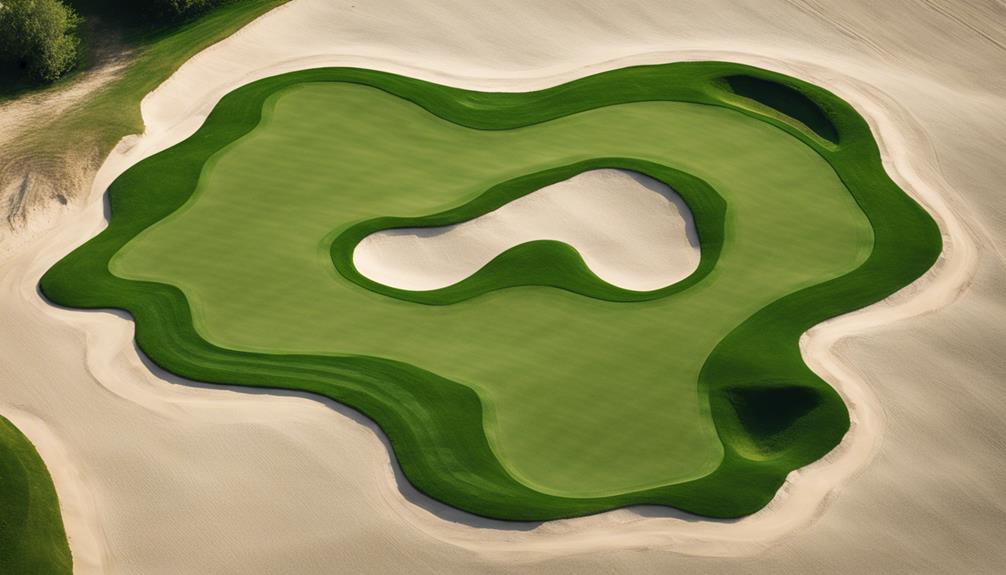Top 10 Tips for Exceptional Golf Course Landscaping
When it comes to creating an exceptional golf course landscape, it's crucial to pay attention to the finer details. From the selection of the right grass varieties to strategic water feature placement and integrating native plants for sustainability, each element plays a significant role.
But what makes a golf course truly stand out are the subtle yet impactful touches that elevate the overall design. Stay tuned to uncover the remaining top tips that will help you achieve a landscape that not only looks stunning but also enhances the golfing experience.
Selecting the Right Grass Varieties
Choosing the best grass varieties for your golf course is crucial for maintaining its pristine appearance and optimal playing conditions. Grass maintenance plays a significant role in the overall aesthetics and playability of your course. When it comes to turf selection, consider factors such as climate, soil type, sunlight exposure, and foot traffic.
To ensure your golf course stays in top shape, regular grass maintenance is essential. This includes mowing, watering, fertilizing, and aerating the turf. Different grass varieties have varying needs, so it's important to choose ones that align with your maintenance capabilities and resources. Conduct soil tests to determine the pH levels and nutrient content, helping you select grass types that will thrive in your specific environment.
When selecting grass varieties, think about the amount of shade and sunlight different areas of your golf course receive. Some grasses, like Bermuda grass, thrive in full sunlight, while others, such as Fine Fescue, are more shade-tolerant. By choosing the right grass for each area based on sunlight exposure, you can ensure uniform growth and consistent playing conditions throughout the course.
Strategic Water Features Placement
For optimal aesthetics and course design, strategically placing water features can enhance the visual appeal and challenge of your golf course. When considering water features, it's essential to incorporate water conservation strategies to ensure sustainability and minimize the environmental impact. By implementing systems such as rainwater harvesting and utilizing recycled water, you can maintain the beauty of your course while being mindful of water usage.
Integrating aquatic plantings within your water features not only adds to the overall attractiveness of the landscape but also creates a habitat for wildlife. Selecting native aquatic plants can further enhance the ecological balance of the area, providing food and shelter for various species. Additionally, incorporating floating islands or wetland areas can improve water quality by naturally filtering out impurities and excess nutrients.
When strategically placing water features, consider the visual impact on the course layout. Water bodies can be used to frame certain holes, creating stunning vistas for players and spectators alike. Moreover, incorporating water hazards strategically can add an extra layer of challenge to the game, requiring players to strategize their shots carefully.
Implementing Proper Irrigation Systems
To ensure efficient water distribution and maintain the health of your golf course landscape, implementing proper irrigation systems is crucial. Water conservation strategies should be at the forefront of your irrigation planning. Installing smart watering techniques such as drip irrigation or soil moisture sensors can help optimize water usage by delivering water directly to the roots where it's needed most.
Efficient drainage solutions are equally important to prevent water wastage and ensure that excess water doesn't pool on the course, leading to soggy or flooded areas.
Incorporating drought-resistant plantings into your landscaping not only reduces the need for excessive watering but also helps in maintaining the aesthetic appeal of the course during dry spells. Native plants are a great choice as they're well-adapted to the local climate and require minimal supplemental watering once established.
Integrating Native Plants for Sustainability
When considering sustainability in your golf course landscaping, incorporating native plants is key to thriving with minimal water input. By utilizing plants that are naturally adapted to the local climate and soil conditions, you can create a more resilient and eco-friendly landscape. Here are some tips to help you integrate native plants effectively:
- Pollinator Gardens: Native plants are excellent choices for creating pollinator-friendly gardens. These plants attract important pollinators like bees and butterflies, promoting biodiversity and supporting the overall health of your golf course ecosystem.
- Wildlife Habitats: Native plants provide food and shelter for local wildlife, helping to create diverse habitats within your golf course. By incorporating a variety of native species, you can attract birds, insects, and other animals, enhancing the natural beauty of your landscape.
- Drought Resistant Landscaping: Native plants are well-suited to local water conditions, often requiring less irrigation than non-native species. By choosing drought-resistant native plants, you can reduce water usage on your golf course, contributing to water conservation efforts and lowering maintenance costs.
Integrating native plants into your golf course landscaping not only promotes sustainability but also adds beauty and uniqueness to your course. Consider consulting with local experts to select the best native plants for your specific region and site conditions.
Focusing on Bunker Design and Placement

Enhance your golf course's aesthetic appeal and strategic challenge by carefully considering bunker design and placement. Bunkers play a crucial role in the overall design and difficulty of a golf course.
When it comes to bunker maintenance, regular upkeep is essential to ensure they remain in top condition. Proper maintenance includes raking the sand regularly to provide a smooth and consistent playing surface, as well as checking for any drainage issues to prevent water accumulation.
In terms of sand selection, choosing the right type of sand for your bunkers is paramount. The sand not only affects the aesthetics but also the playability of the bunker. Opt for high-quality, angular sand that will provide good drainage and proper texture for shots to hold up well. Regularly inspect the sand quality and replenish it as needed to maintain optimal playing conditions.
When designing the placement of bunkers, strategically position them to challenge golfers of all skill levels. Placing bunkers near landing areas or along the sides of fairways can create strategic dilemmas for players, forcing them to carefully consider their shot selection. Additionally, consider the visual impact of bunkers by incorporating them into the natural landscape seamlessly.
Incorporating Natural Hazard Features
Consider incorporating natural hazard features strategically to add both aesthetic appeal and challenge to your golf course layout. By utilizing the natural contours of the land and placing hazards thoughtfully, you can create a visually stunning and engaging course for players of all levels.
Here are some key tips to help you make the most of natural hazard features:
- Natural Contours: Study the natural slopes, dips, and elevations of the land to determine how you can incorporate them into your hazard design. By working with the existing topography, you can enhance the beauty of the course while also creating natural challenges for golfers. Utilize hills, valleys, and water bodies to add interest and difficulty to different holes.
- Hazard Placement: Carefully place hazards such as bunkers, water features, and rough areas to strategic points along the course. Consider how these hazards will affect the playability of each hole and the overall flow of the course. Placing hazards near landing areas, around greens, or along fairways can force golfers to think strategically about their shots and add excitement to their round.
- Blend with Nature: Ensure that your hazard features blend seamlessly with the surrounding landscape. Use native plants, rocks, and other natural elements to create hazard areas that look like they belong in the environment. This integration not only enhances the visual appeal of the course but also helps maintain the ecological balance of the area.
Enhancing Aesthetics With Landscape Lighting

Illuminate your golf course's beauty and charm by strategically incorporating landscape lighting to enhance its aesthetics. Ambient lighting plays a crucial role in creating a welcoming atmosphere on the course. By strategically placing lights around key features such as water hazards, sand traps, and putting greens, you can highlight these areas even during the evening hours. This not only adds a touch of elegance to your golf course but also ensures that players can navigate the course with ease.
In addition to ambient lighting, pathway illumination is essential for both aesthetics and safety. By lining your cart paths and walkways with subtle lighting fixtures, you not only enhance the visual appeal of these areas but also provide guidance for golfers moving around the course after sunset. Pathway illumination can create a magical ambiance, especially when combined with the natural beauty of your landscaping.
When incorporating landscape lighting, consider the placement of fixtures carefully to avoid glare or harsh shadows. Soft, diffused lighting can create a more inviting atmosphere and showcase your golf course in its best light. By focusing on ambient lighting and pathway illumination, you can elevate the overall aesthetics of your golf course and provide an unforgettable experience for players.
Creating Functional Cart Paths and Walkways
To ensure smooth navigation and enhance the functionality of your golf course, focus on designing well-planned cart paths and walkways. Properly designed pathways not only guide golfers efficiently but also add to the overall aesthetics of the course.
When creating functional cart paths and walkways, keep the following tips in mind:
- Consider the Terrain: Take into account the natural landscape of your golf course, especially if you have elevated tees or sloping fairways. Design paths that flow naturally with the land, ensuring golfers can move around easily without facing steep inclines or declines.
- Use Durable Materials: Opt for durable materials that can withstand heavy traffic and varying weather conditions. Materials like concrete, asphalt, or compacted gravel are popular choices for cart paths due to their longevity and low maintenance requirements.
- Ensure Proper Drainage: Proper drainage is crucial to prevent water accumulation on paths, especially in areas with sloping fairways. Incorporate drainage solutions like culverts or strategic grading to direct water away from pathways and maintain a safe environment for golfers.
Frequently Asked Questions
How Can Golf Course Landscaping Contribute to Wildlife Conservation Efforts?
To help with wildlife conservation efforts, golf course landscaping plays a crucial role by providing essential habitats for various species. By creating biodiversity corridors within the course, you can support a diverse range of wildlife.
These corridors offer shelter, food sources, and safe passage for animals, contributing significantly to the preservation of biodiversity. When designing your golf course landscape, keeping these aspects in mind can make a real difference in conservation efforts.
What Considerations Should Be Made for Minimizing Environmental Impacts During Golf Course Landscaping Projects?
When planning golf course landscaping, keep sustainability in mind. Implement sustainable practices to minimize environmental impact.
Integrate biodiversity to support local wildlife. Focus on water conservation techniques to reduce usage.
Utilize erosion control methods to protect the land.
Are There Any Specific Regulations or Guidelines That Golf Course Owners Should Be Aware of When Planning Landscaping Projects?
When planning landscaping projects for your golf course, it's crucial to be aware of specific regulations and planning guidelines. Regulations may vary by location, so check with local authorities for any restrictions.
Following guidelines on water usage, pesticide application, and native plant species can help ensure compliance and environmental sustainability.
How Can Golf Course Landscaping Help Improve Player Experience and Course Playability?
Improving player satisfaction and aesthetics on your golf course through strategic landscaping choices can greatly enhance the overall experience.
Thoughtful design not only makes the course visually appealing but also influences playability.
By selecting vegetation that requires less water and maintenance, you can boost sustainability efforts.
Well-maintained landscapes contribute to a positive atmosphere for players and can even impact their performance on the course.
What Are Some Innovative Trends in Golf Course Landscaping That Are Gaining Popularity?
To keep up with innovative trends in golf course landscaping, many are turning to water-saving techniques and sustainable design. Incorporating native plantings not only adds beauty but also helps with erosion control.
Conclusion
In conclusion, by following these top 10 tips for exceptional golf course landscaping, you can create a beautiful and sustainable environment that enhances the overall playing experience for golfers.
From selecting the right grass varieties to incorporating native plants and strategic water features, each aspect plays a crucial role in creating a visually stunning and functional golf course.
Implementing these tips won't only improve the aesthetics of the course but also contribute to its long-term success and sustainability.
